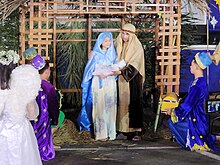Christmas in the Philippines
As one of the two predominantly Catholic countries in Asia (the other one being East Timor), the Philippines celebrates the world's longest Christmas season (Filipino: Kapaskuhan),[1][3] spanning what it refers to as the "ber months".The Simbang Gabi is practiced mainly by Catholics and Aglipayans, with some Evangelical Christian and independent Protestant churches having adopted the practise of pre-Christmas dawn services.Some Aglipayan churches invite the congregation to partake of the "paínit" (literally, "heater"), a post-Mass snack of mostly rice pastries served with coffee or cocoa at the house of the Mass sponsor.Common traditional dishes served for the meal include: lechón, various types of pancit (noodles), Filipino spaghetti, hamonado, jamón, queso de bola, morcón, embutido, chicken galantina, almondigas (meatballs), paelya (arroz valenciana, bringhe, etc.), lumpia, menudo, mechado, caldereta, callos, chicken pastel, relyenong bangús (stuffed milkfish), lengua estofado, adobo, and various types of barbecue (inihaw).The elder often responds by reciting a blessing or simply acknowledging the gesture, and in return gives "Aguinaldo" or money in the form of crisp banknotes, often placed in a sealed envelope such as an ang pao.Filipinos do hang out with family and friends at the park or plaza with illuminating colorful lights and giant Christmas tree or shopping to buy for a gifts and dine in at the malls.In spite of the yearly ban (due to the national government restrictions), people in most towns and cities customarily light firecrackers, or employ safer methods of merrymaking such as banging on pots and pans and blowing car horns.Other traditions and beliefs include encouraging children to jump at the stroke of midnight to increase their height; displaying circular fruit such as oranges; wearing clothes with dots and other circular designs to symbolize coins and money; eating twelve grapes at midnight for good luck in the twelve months of the year (a Spanish custom); and opening all windows and doors to let in the blessings on the first day of the year.The Black Nazarene, whose devotees are primarily centered in Manila and Cagayan de Oro, is borne in procession on January 9 after a novena in its honor.The date commemorates the image's 1787 Traslación (solemn transfer) from its original location in what is now Rizal Park to its present shrine in the Quiapo District of the city.In 1521, Ferdinand Magellan came to Cebú and gave the image as a present to Humamay, chief consort of the local monarch, Raja Humabon, when she, together with her husband and a number of his subjects, were baptized into the Catholic faith.The National Cathedral or the Central Church of the Iglesia Filipina Independiente or Aglipayans is dedicated to the Santo Niño and other several parishes and missions around the country.In older traditions (which are still kept in the liturgical calendar of the Extraordinary Form of the Mass) Christmas lasted until Candlemas, or the Feast of the Purification of Mary and the Presentation of the Baby Jesus at the Temple.This date falls on February 2, after Mary had participated in a rite of purification in according to the ancient Candlemas festival rooted in Halakha (Jewish law).Present-day paról has endless possible shapes and forms and is made of a variety of materials, such as cellophane, plastic, rope, capiz shell, glass, and even recycled refuse.Derived from the Spanish name for Bethlehem, Belén, it depicts the infant Jesus in the manger, surrounded by the Virgin Mary, St. Joseph, the shepherds, their flock, the Magi and some stable animals, and is surmounted by an angel, the Star or both.An example of a traditional Filipino carol is a part of a series known as "Maligayang Pasko", which is commonly called "Sa maybahay ang aming bati".Its prevalent use may have originated from Filipino workers of the Spanish era, receiving extra pay from the generosity of the rich employers during the celebration of the Christmas season.










ParolsChristmas lightsChristmasFilipinoChristian worldpublic holiday in the countryother countriesEast TimorChristmas seasonChristmas musicChristmastideNew Year's DaySanto NiñoLiturgicallyCatholic ChurchAdventThree Kings' DayPhilippine languagesassimilatedover the yearsPassoverlanguages spoken in the countryChavacanoSpanish-based creoleHiligaynonIlocanoKapampanganTagalogcarollerChristmas giftCatholicismethnic groups in the PhilippinesSimbang GabiManila CathedralChristmas treesSpanishMisa de GallonovenaMassesCatholicsAglipayansEvangelical ChristianProtestantChrist's birthtraditional Filipino holiday farebibingkabrown sugarcoconuttsokolatehot chocolatePhilippineslechónChristmas EveMidnight MassNoche BuenaFilipino SpanishChristmas dinnerNew Year's EvepancitFilipino spaghettihamonadojamónqueso de bolamorcónembutidochicken galantinaalmondigaspaelyaarroz valencianabringhelumpiamenudomechadocalderetacalloschicken pastelrelyenongbangúslengua estofadoinihawúbe halayáleche flanmacaroni saladmembrilyofruit saladbuko saladcrema de frutaensaymadachamporadomango floatfruitcakeroasted chestnutskakaninputo bumbongsapin-sapinBatangasJosephVirgin MaryLas PosadasMisamis OrientalUniversity of Santo TomasChristmas DayPágmamánobanknotesang paoHoly InnocentsChildermaspractical jokesApril Fool's DayCebu–Cordova Link ExpresswayfirecrackersFeast of the EpiphanyTwelfth NightFeast of the Black NazareneQuiapo, ManilaBlack NazareneManilaCagayan de OroRizal Parkits present shrineSanto Niño de CebúFerdinand MagellanRaja HumabonbaptizedJoan of CastileSinulog
